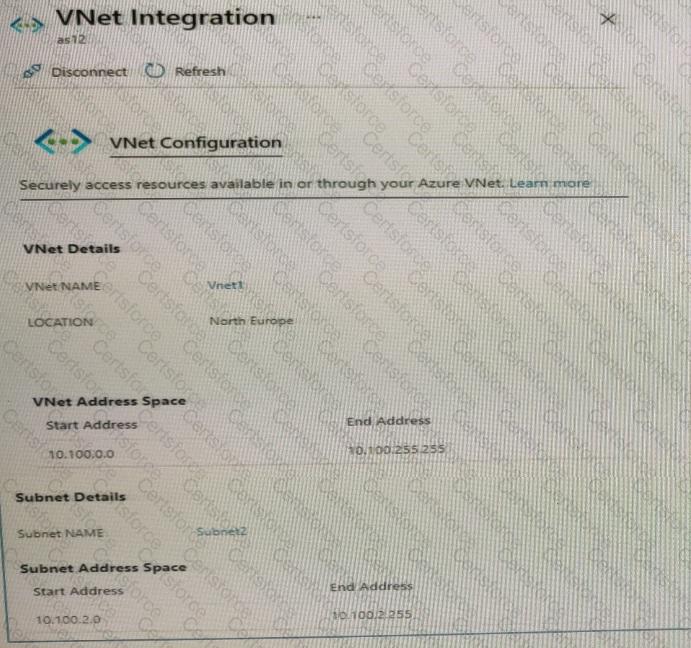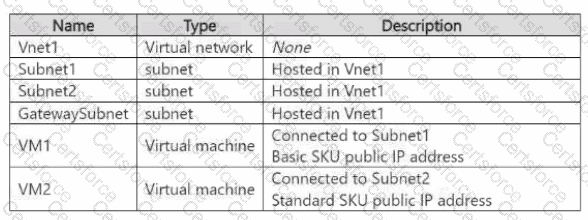You are planning the IP addressing for the subnets in Azure virtual networks. Which type of resource requires IP addresses in the subnets?
You have an Azure virtual network that contains two subnets named Subnet1 and Subnet2. Subnet1 contains a virtual machine named VM1. Subnet2 contains a virtual machine named VM2.
You have two network security groups (NSGs) named NSG1 and NSG2. NSG1 has 100 inbound security rules and is associated to VM1. NSG2 has 200 inbound security rules and is associated to Subnet1.
VM2 cannot connect to VM1.
You suspect that an NSG rule blocks connectivity.
You need to identify which rule blocks the connection. The issue must be resolved as quickly as possible.
Which Azure Network Watcher feature should you use?
You have an Azure subscription that contains the resources is shown in the following table.

You need to ensure that the apps hosted on VM1 can resolve the IP address of the What should you create first?
You have two Azure App Service instances that host the web apps shown the following table.

You deploy an Azure application gateway that has one public frontend IP address and two backend pools.
You need to publish all the web apps to the application gateway. Requests must be routed based on the HTTP host headers.
What is the minimum number of listeners and routing rules you should configure? To answer, select the appropriate options in the answer area.
NOTE: Each correct selection is worth one point.

You have the Azure App Service app shown in the App Service exhibit.

The VNet Integration settings for as12 are configured as shown in the Vnet Integration exhibit.

The Private Endpoint connections settings for as12 are configured as shown in the Private Endpoint connections exhibit.

For each of the following statements, select Yes if the statement is true. Otherwise, select No.
NOTE: Each correct selection is worth one point.

You have an on-premises network named Site1.
You have an Azure subscription that contains a storage account named storage1 and a virtual network named VNet1. VNet1 contains a subnet named Subnet1. A private endpoint for storage1 is connected to Subnet1 Site1 is connected to VNet1 by using a Site-to-Site (S2S) VPN.
You need to control access to storage1 from Site1 by using network security groups (NSGs).
What should you do first?
You have an Azure subscription that contains the resources shown in the following table.

You plan to deploy an Azure Virtual Network NAT gateway named Gateway 1. The solution must meet the following requirements:
• VM1 will access the internet by using its public IP address.
• VM2 will access the internet by using its public IP address.
• Administrative effort must be minimized.
You need to ensure that you can deploy Gateway1 to Vnet1.
What is the minimal number of subnets that Vnet1 must have?
You have an Azure subscription. The subscription contains multiple Azure SQL Database resources and a virtual network named VNet1 that has five subnets. All the subnets are associated with a network security group (NSG) named NSG1. NSG1 blocks all outbound traffic, unless specifically allowed by a rule.
Each subnet contains 50 virtual machines. Multiple virtual machines host instances of SQL Server on Virtual Machines and will be configured to replicate with the Azure SQL Database resources.
You need to configure a new outbound rule in NSG1 to allow the SQL Server on Virtual Machines instances to connect to the Azure SQL Database resources. The solution must meet the following requirements:
• Minimize modifications to NSG1 when additional instances of SQL Server on Virtual Machines are deployed.
• Ensure that only SQL Server on Virtual Machines instances can connect to the Azure SQL Database resources.
How should you configure each setting for the new outbound rule? To answer, select the appropriate options in the answer area.
NOTE: Each correct selection is worth one point.

You are configuring two network virtual appliances (NVAs) in an Azure virtual network. The NVAs will be used to inspect all the traffic within the virtual network.
You need to provide high availability for the NVAs. The solution must minimize administrative effort. What shtraffic ould you include in the solution?
Note: This question is part of a series of questions that present the same scenario. Each question in the series contains a unique solution that might meet the stated goals. Some question sets might have more than one correct solution, while others might not have a correct solution.
After you answer a question in this section, you will NOT be able to return to it. As a result, these questions will not appear in the review screen.
You have an Azure subscription that contains an Azure Virtual WAN named VWAN1. VWAN1 contains a hub named Hub1.
Hub1 has a security status of Unsecured.
You need to ensure that the security status of Hub1 is marked as Secured.
Solution: You implement Azure Web Application Firewall (WAF).
Does this meet the requirement?